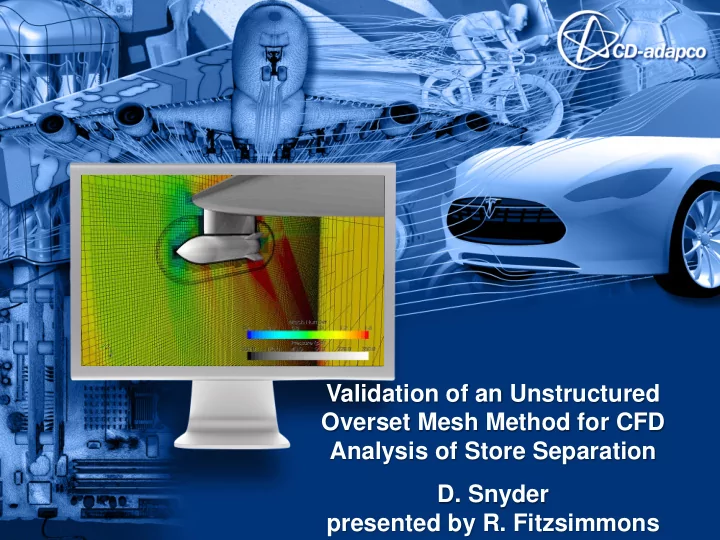

Validation of an Unstructured Overset Mesh Method for CFD Analysis of Store Separation D. Snyder presented by R. Fitzsimmons
Stores Separation – Introduction Flight Test – Expensive, high-risk, sometimes catastrophic loss of aircraft Wind Tunnel – Captive Trajectory (CTS) methods developed in 1960’s – Expensive, require very small scale models – Difficulty in bays and multiple-stores releases CFD – CFD-Generated Aerodynamic Database • Database of steady-state CFD solutions (1000s) • “Grid” approach to build interference aerodynamics database • Database lookup within 6DOF model • 1000’s of Monte-Carlo runs once model is constructed – CFD-in-the-Loop • Couples CFD with the 6DOF solver • Typically used to verify behavior of aerodynamic database + 6DOF
Stores Separation – CFD CFD Approaches – Block-structured overset mesh • Difficult, complicated meshing • Many overset boundaries leads to significant interpolation – Dynamic morphing/remesh • Issues controlling volume mesh density during motion • Does not work well for “shearing” motions • High computational cost (~20-30%) • No benefit for “grid” approach – Unstructured overset mesh • Best of both worlds: ease of meshing / fewer overset boundaries • As implemented in STAR-CCM+
Overset Mesh Many Industries – Aerospace, Marine, Automotive, Manufacturing, etc. Aero Applications – Parametric Studies • Fewer meshes to build • Same mesh quality in important regions – Same bodies at different relative positions / orientations • Stores separation “grid” approach • Control surface deflections • High-lift configurations • Rotorcraft • Tube/Silo launches – Bodies with complicated motion pattern • Prescribed or coupled 6DOF
Arbitrary Unstructured Meshes Complex geometries need not be broken down into simpler shapes Reduces number of interfaces / interpolations Any combination of mesh topologies (hex, tet, poly, etc.)
Implicit Grid Coupling Solution is computed on all grids simultaneously Interpolation factors are included in the linear system(s) Improved robustness – Especially in regions of sharp gradients Improved convergence External Aero, Mach 0.7
Overset Interface Interpolation Control volumes are labeled as: – Active cells (may be donors) • Regular discretized equations are solved – Coupling (acceptors) • Algebraic equations are solved – values are expressed via variables at a certain number of donor cells on other grid • Many possibilities, currently use linear shape functions – Passive • These cells are temporarily or permanently de-activated
Defining Overset Interfaces Each region (“grid”) meshed independently – Can use different mesh topologies – Cells should be similar sized at interface Multiple-select regions, select Create Interface → Overset Mesh Position and orient foreground region(s) as desired Cell types (active, coupling, passive, etc.) determined automatically as needed. 8
Wing/Pylon/Store Benchmark Case Geometry – Clipped delta wing with pylon – Standard 4-fin store ~10ft in length Benchmark wind tunnel data available at Mach 1.2 – Trajectory information – Surface pressure
Computational Mesh Unstructured Cartesian Trim Cell – Cells refined in region of expected store travel – Cell refined around store (nose, tips, wake) – Minimum of 4 cells across the small 1.4” gap between pylon and store 3.8M Cells Overall – 3.0M Farfield/Wing/Pylon – 0.8M Store Lateral extents located at approximately 100 diameters
Solver Settings Density-based Coupled Solver Inviscid Flow – Previous studies have shown this is sufficient for trajectory calculation 2 nd -Order upwind spatial discretization 2 nd -Order implicit temporal discretization – Implicitly-coupled 6DOF motion – ∆ t = 0.01s nominal, and and 0.002s fine
Ejector Forces Definition Modeled as arbitrary point loads – Defined through the GUI – Custom functional relationships to match ejector force and stroke length Visualize loads real-time – Note that initial motion is dominated by ejector forces
Visualization – Overall Trajectory Initial nose-up motion due to ejector forces Store rolls and yaws outboard
Visualization – Overset Region Overset domain initially overlaps pylon Overset domain falls through refined region in background grid Shock structures can be seen
Visualization – Small Gap Flow within the small pylon/store gap is resolved Automatic activation/de-activation of cells is seen
Surface Pressures t = 0.00 t = 0.16 t = 0.37
Trajectory: Position / Velocity Results are nearly identical for nominal and fine time step Y- and Z-position and velocity are in excellent agreement Aft-ward X-movement is underpredicted – Common for this benchmark case – NOT due to viscous effects – Likely due to wind tunnel sting corrections
Trajectory: Angle / Angular Rates Fine time step shows improved results, but only slightly Pitch and roll are in good agreement Initial outward yaw rate is underpredicted – Initial rates are dominated by ejector forces – Further investigation is needed to determine difference between CFD and WT ejector force definition
Conclusions STAR-CCM+ unstructured overset mesh approach shown to be effective and successful for transonic stores separation – Trajectories are predicted well – Surface pressures are in excellent agreement – Quick turn-around time • Meshing: ~ 1 hour from raw CAD model • Solution: 2 hrs on 6-core workstation for nominal ∆ t Future Work – Multiple moving bodies (ripple-release) – Constrained relative motion – Automatic mesh adaption – Collision modeling
Questions?
Recommend
More recommend